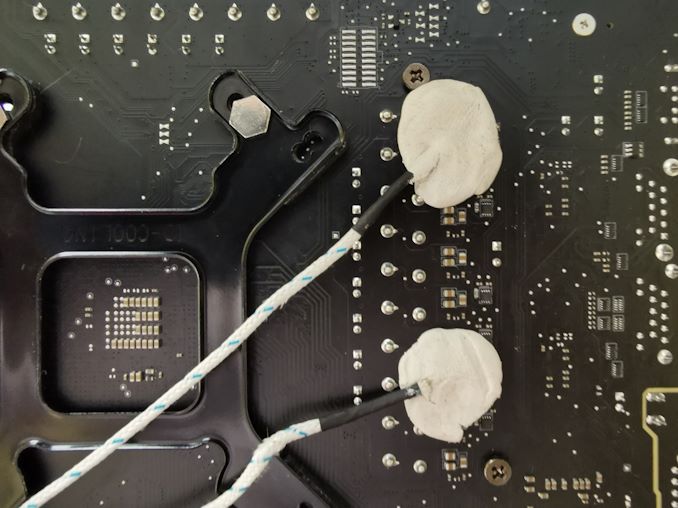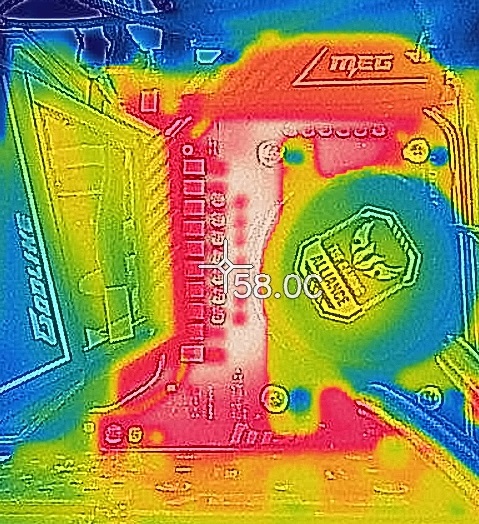The MSI MEG X570 Godlike Motherboard Review: Thor's Flagship
by Gavin Bonshor on August 28, 2019 12:00 PM EST- Posted in
- Motherboards
- AMD
- MSI
- 10G Ethernet
- Ryzen
- PCIe 4.0
- Ryzen 3000
- X570
- X570 Godlike
- MEG
Power Delivery Thermal Analysis
One of the most requested elements of our motherboard reviews revolves around the power delivery and its componentry. Aside from the quality of the components and its capability for overclocking to push out higher clock speeds which in turn improves performance, is the thermal capability of the cooling solutions implemented by manufacturers. While almost always fine for users running processors at default settings, the cooling capability of the VRMs isn't something that users should worry too much about, but for those looking to squeeze out extra performance from the CPU via overclocking, this puts extra pressure on the power delivery and in turn, generates extra heat. This is why more premium models often include heatsinks on its models with better cooling designs, heftier chunks of metal, and in some cases, even with water blocks such as the ASUS ROG Crosshair VIII Formula.

Two K-Type Thermal Probes attached to the rear of the power delivery on the MSI MEG X570 Godlike
Testing Methodology
Out method of testing out if the power delivery and its heatsink are effective at dissipating heat, is by running an intensely heavy CPU workload for a prolonged method of time. We apply an overclock which is deemed safe and at the maximum that the silicon on our AMD Ryzen 7 3700X processor allows. We then run the Prime95 with AVX2 enabled under a torture test for an hour at the maximum stable overclock we can which puts insane pressure on the processor. We collect our data via three different methods which include the following:
- Taking a thermal image from a birds-eye view after an hour with a Flir Pro thermal imaging camera
- Securing two probes on to the rear of the PCB, right underneath CPU VCore section of the power delivery for better parity in case a probe reports a faulty reading
- Taking a reading of the VRM temperature from the sensor reading within the HWInfo monitoring application
The reason for using three different methods is that some sensors can read inaccurate temperatures, which can give very erratic results for users looking to gauge whether an overclock is too much pressure for the power delivery handle. With using a probe on the rear, it can also show the efficiency of the power stages and heatsinks as a wide margin between the probe and sensor temperature can show that the heatsink is dissipating heat and that the design is working, or that the internal sensor is massively wrong. To ensure our probe was accurate prior to testing, I personally binned 10 and selected the most accurate (within 1c of the actual temperature) for better parity in our testing.
For thermal image, we use a Flir One camera as it gives a good indication of where the heat is generated around the socket area, as some designs use different configurations and an evenly spread power delivery with good components will usually generate less heat. Manufacturers who use inefficient heatsinks and cheap out on power delivery components should run hotter than those who have invested. Of course, a $700 flagship motherboard is likely to outperform a cheaper $100 model under the same testing conditions, but it is still worth testing to see which vendors are doing things correctly.
Thermal Analysis Results

We measured 58°C on PCB between the CPU socket and power delivery
The MSI MEG X570 Godlike is running a 14-phase design for the CPU VCore section. This includes an International Rectifier IR35201 running in a 7+1 configuration with seven IR3599 doublers on the rear of the PCB; the SoC section is running four phases off a single IR3599 which splits the signal into four. As far as designs go, this is MSI's best AMD power delivery that I can recall seeing, although I still find it a little odd that the SoC section is split into four, but through one IR3599 doubler in quad mode. Perhaps this will yield some benefits and gains for extreme overclockers, but it's not an issue for general users to be concerned about. The heatsink is very similar to the MSI MEG X570 Ace and uses the same design. The power delivery heatsinks are interconnected by a heat pipe which stretches around the left side of the memory slots and down into the actively cooled X570 chipset heatsink.
As we get more results, we will endeavour to update this chart when more models have been tested
Note - The ASRock B450 Gaming ITX-ac model crashed instantly every time the small FFT torture test within Prime95 was initiated. At anything on the CPU VCore above 1.35 V would result in instant instability. The Ryzen Master auto-overclocking function failed every time it tried to dial in settings, but it does however operate absolutely fine at stock, and with Precision Boost Overdrive enabled. Either the firmware is the issue, or the board just isn't capable of overclocking the Ryzen 3700X with extreme workloads with what is considered a stable overclock on the X570 chipset. We will re-test this in the future.
The power delivery on the MSI MEG X570 Godlike actually runs slightly cooler in our testing which can be explained by having a slightly better 14+4 power delivery versus the 12+2 design on the MSI MEG X570 Ace. More phases usually generate less heat overall as each phase is active for a shorter period of time, which does show in our testing. We ran our AMD Ryzen 7 3700X testbed sample at 4.1 GHz with a CPU VCore of 1.45 V which is consistent with other models we have tested to try and generate as much heat as possible. The power delivery probe output reading was 59°C after an hour of testing, while the VRM temperature sensor gave us a reading of 61°C. The MSI MEG X570 Godlike does well under our testing method and there should be no issues when overclocking the current Ryzen 3000 processors, as we found that we hit CPU thermal limitations before anything else.











116 Comments
View All Comments
oynaz - Saturday, August 31, 2019 - link
I actually prefer more cores to faster cores in my DAW. Each effect bus, or track, cannot be split into multiple cores, true, but you usually quite a few buses going.inighthawki - Friday, August 30, 2019 - link
GamingSweetbabyjays - Thursday, August 29, 2019 - link
In a professional setting, where you are doing thread intensive workloads, and IT is not cool with you overclocking...then yes, I totally agree 3900x makes way more sense."use less power overall" ? 9900k has a TDP of 95W, while the 3900x has a TDP of 105W, Additionally the Z390 chipset has a TDP of 6W while the X570 has a TDP of 11W. Now I know there is a discrepancy between how AMD and Intel measure TDP, so the numbers at face value may not be telling the whole story. That said, I would be very interested to see overall system power draw for both to test the veracity of your statement.
AshlayW - Thursday, August 29, 2019 - link
Oh boy, you actually think the 9900K uses 95W? Joke's on you pal, that's at 3.6 GHz. At full turbo clocks the 9900K uses 150-200W. Ryzen 3000 is almost twice the performance per watt in some scenarios.Trikkiedikkie - Saturday, August 31, 2019 - link
With the 3900 having many things inside the processor, whereas the 9900 has extra chips needed. And Intel's numbers only count for baseclockSweetbabyjays - Thursday, August 29, 2019 - link
"trounce it with it's higher core-count parts in multi-threaded scenarios." Aside from some synthetic benchmarks, I suggest looking at the puget systems website for professional benchmarks, if you're looking for more real world professional performance scenarios.The 12 core part is better in some(in some the 9900k is better) scenarios, but rarely(if ever) by more than 10%. Perhaps your definition of "trounce" is different from mine thought.
If you're gaming much more often than you are working/creating the increased core count really wont improve your overall computing experience, if at all.
Oliseo - Thursday, August 29, 2019 - link
This is true. But the argument remains, just how many people actually use highly mutli-threaded scenarios.I'd wager if you got a venn diagram of gamers and content creators, the content creators would simply be a small spot on the very large gaming circle.
I know a lot of gamers, yet I struggle to meet 3D cad designers or Film Editors.
So yes, you're right, AMD will trounce Intel in that respect. But until we get games using more than 8 cores, the majority of people will not be better off because they simply don't need those extra cores as they don't run any software that can make use of them.
And that goes for AMD folks wanting to get the AMD chips as well.
Trikkiedikkie - Saturday, August 31, 2019 - link
Gaming is soo small compared to people doing actual work.AshlayW - Thursday, August 29, 2019 - link
$150 more, for 10% higher single core performance when both CPUs already have extremely good single core performance, and you can place a 4700X in the same motherboard next year that will have even higher single core than the 9900K? Seriously people, consumer stupidity is why Intel is still selling CPUs.Trikkiedikkie - Saturday, August 31, 2019 - link
Single core is soooo last century.Only people that have very little serious work apart from Adobe want that.